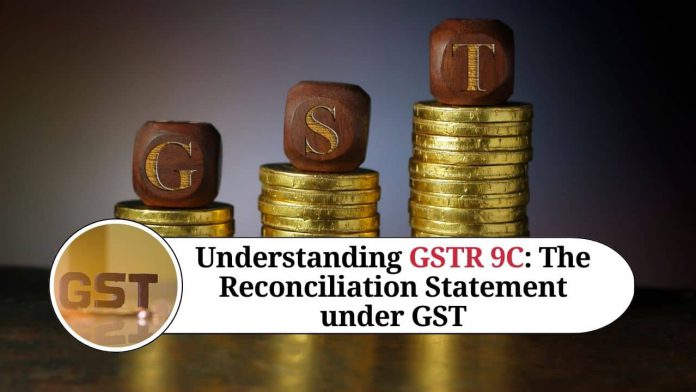Introduction
The Goods and Services Tax (GST) was introduced in India in 2017 to simplify and streamline the country’s indirect tax system. As a part of this system, taxpayers are required to file various types of returns and forms to comply with the regulations.
One such form is GSTR 9C, which is an annual reconciliation statement that needs to be filed by taxpayers who have a turnover exceeding Rs 2 crores. In this blog, we will discuss the basics of GSTR 9C and its various components.
What is GSTR 9C?
GSTR 9C is a reconciliation statement that is filed by taxpayers along with their annual GST return, GSTR 9. It is essentially a statement that reconciles the figures provided in GSTR 9 with the audited financial statements of the taxpayer.
In other words, GSTR 9C is a statement that provides a summary of the taxpayer’s GST returns and their financial statements. It ensures that there is no discrepancy between the two and helps in identifying any errors or discrepancies that may have occurred while filing the returns.
Components of GSTR 9C
The GSTR 9C form has two main components: Part A and Part B.
Part A of GSTR 9C
Part A of GSTR 9C contains details of the taxpayer’s financial statements. This includes the balance sheet, profit and loss statement, and cash flow statement for the relevant financial year.
These statements must be audited by a chartered accountant or a cost accountant. The auditor must then provide their findings and observations in the form of a certification in Part B of the form.
Part B of GSTR 9C
Part B of GSTR 9C contains the reconciliation statement, which compares the taxpayer’s GST returns with their audited financial statements. This includes the following:
- Reconciliation of turnover: This section reconciles the turnover reported in the audited financial statements with the turnover reported in the GST returns.
- Reconciliation of taxes paid: This section reconciles the amount of tax paid as per the audited financial statements with the amount of tax paid as per the GST returns.
- Reconciliation of input tax credit: This section reconciles the input tax credit claimed in the audited financial statements with the input tax credit claimed in the GST returns.
Certification in GSTR 9C
The certification in GSTR 9C is provided by a chartered accountant or a cost accountant. The certification must state that the information provided in Part A is correct and that the reconciliation statement in Part B has been duly verified.
The certification must also mention any discrepancies or observations that were noted during the reconciliation process. If there are any discrepancies, the taxpayer must take corrective action and make necessary adjustments in their GST returns.
Challenges in filing GSTR 9C
Filing GSTR 9C can be a complex process and may present some challenges for taxpayers. Some of the challenges in filing GSTR 9C include:
- Limited time: Taxpayers have a limited amount of time to file GSTR 9C, as the due date is the same as that of GSTR 9. This can be challenging for taxpayers who have a large amount of data to reconcile and may require more time to prepare their financial statements.
- Complex reconciliation process: The reconciliation process in GSTR 9C can be complex, as it involves comparing the figures in the GST returns with the audited financial statements. This can be challenging for taxpayers who may not have the necessary expertise or resources to conduct a thorough reconciliation.
- Dependence on auditors: Taxpayers are required to have their financial statements audited by a chartered accountant or a cost accountant, who then provides the certification in Part B of GSTR 9C. This can be challenging for taxpayers who may not have access to qualified auditors or may face delays in obtaining the necessary certifications.
- Lack of clarity: The GST regulations and forms are subject to frequent changes, which can sometimes result in a lack of clarity regarding the filing requirements. This can be challenging for taxpayers who may struggle to understand the requirements and may require additional guidance or support.
Penalties for non-filing or late filing of GSTR 9C
Non-filing or late filing of GSTR 9C can result in penalties and fines for taxpayers. The penalties for non-filing or late filing of GSTR 9C are as follows:
Late fee: A late fee of Rs 200 per day (Rs 100 per day for CGST and Rs 100 per day for SGST) is applicable for the period during which the GSTR 9C is not filed, subject to a maximum of 0.25% of the taxpayer’s turnover in the state or union territory.
Interest: In addition to the late fee, interest is also applicable on the amount of tax payable. The interest rate is 18% per annum and is calculated from the date on which the tax was due to the date on which it is paid.
Penalty: A penalty of Rs 10,000 or 0.25% of the taxpayer’s turnover in the state or union territory, whichever is higher, is applicable for non-filing or incorrect filing of GSTR 9C.
It is important for taxpayers to file GSTR 9C on time and ensure that the information provided in the form is accurate to avoid penalties and fines.
GSTR 9C audit
GSTR 9C audit is conducted by a chartered accountant or a cost accountant to verify the accuracy and completeness of the information provided in GSTR 9C. The audit includes a review of the financial statements and GST returns, as well as an examination of the reconciliation statement in GSTR 9C.
The auditor is required to provide an audit report in Part B of GSTR 9C, which includes their opinion on the accuracy and completeness of the information provided in GSTR 9C. If the auditor identifies any discrepancies or errors in the information provided in GSTR 9C, they are required to report these to the taxpayer and make appropriate recommendations for correction.
Conclusion
In conclusion, GSTR 9C is an important form that taxpayers with a turnover exceeding Rs 2 crores need to file along with their annual GST return, GSTR 9. It is a reconciliation statement that ensures that the figures provided in the GST returns are in line with the audited financial statements of the taxpayer.
The form has two main components: Part A, which contains details of the financial statements, and Part B, which contains the reconciliation statement. The certification in GSTR 9C is provided by a chartered accountant or a cost accountant and must state that the information provided in Part A is correct and that the reconciliation statement in Part B has been duly verified.
The GSTR 9C audit conducted by a chartered accountant or a cost accountant helps verify the accuracy of the information provided in GSTR 9C and ensures compliance with the GST regulations.
Read more useful content:
Frequently Asked Questions (FAQs)
Q1.) Who needs to file GSTR 9C?
Taxpayers with a turnover exceeding Rs 2 crores are required to file GSTR 9C along with GSTR 9.
Q2.) Is it mandatory to file GSTR 9C?
Yes, it is mandatory for eligible taxpayers to file GSTR 9C as per the GST regulations.
Q3.) What is the due date for filing GSTR 9C?
The due date for filing GSTR 9C is the same as that of GSTR 9, which is 31st December of the following financial year.
Q4.) What is the penalty for non-filing or late filing of GSTR 9C?
A late fee of Rs 200 per day (Rs 100 per day for CGST and Rs 100 per day for SGST) is applicable for the period during which the GSTR 9C is not filed, subject to a maximum of 0.25% of the taxpayer’s turnover in the state or union territory. In addition, interest and penalty may also be applicable.
Q5.) What is the process for filing GSTR 9C?
GSTR 9C can be filed online on the GST portal. The form must be prepared in two parts – Part A (Reconciliation statement) and Part B (Certification by auditor). The taxpayer must first prepare Part A and then have their financial statements audited by a chartered accountant or a cost accountant before filing Part B.
Q6.) What is the purpose of GSTR 9C?
The purpose of GSTR 9C is to reconcile the figures in the GST returns with the audited financial statements and ensure the accuracy and completeness of the taxpayer’s financial transactions.
Q7.) What is the difference between GSTR 9 and GSTR 9C?
GSTR 9 is an annual return that provides a summary of the taxpayer’s outward and inward supplies during the financial year. GSTR 9C, on the other hand, is a reconciliation statement that verifies the accuracy and completeness of the information provided in GSTR 9.
Q8.) Can GSTR 9C be revised?
No, GSTR 9C cannot be revised once it has been filed.
Q9.) Is there any format for preparing the financial statements for GSTR 9C?
No, there is no prescribed format for preparing the financial statements for GSTR 9C. However, the financial statements must comply with the applicable accounting standards and must provide all the necessary information required for reconciliation with the GST returns.
Q10.) Can GSTR 9C be filed without the certification by the auditor?
No, GSTR 9C cannot be filed without the certification by the auditor in Part B of the form.




















